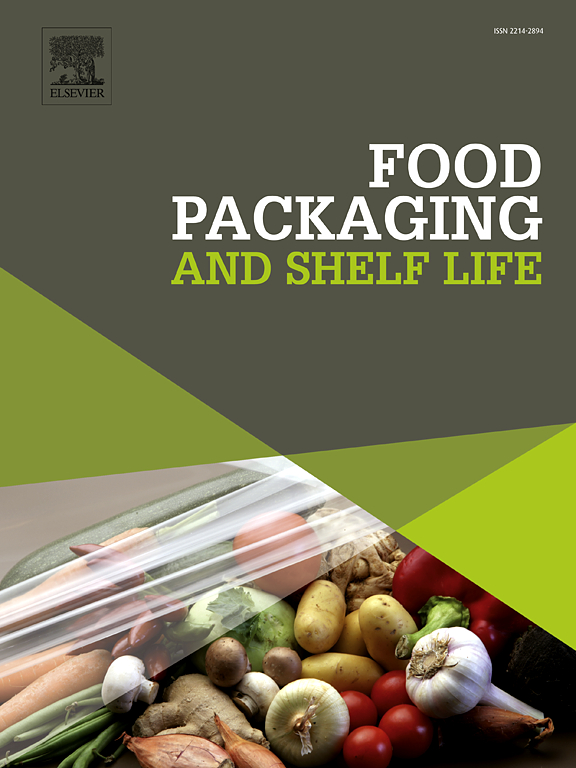β-cryptoxanthin encapsulated chitosome: An innovative coating for raw chicken meat preservation
IF 10.6
1区 农林科学
Q1 FOOD SCIENCE & TECHNOLOGY
引用次数: 0
Abstract
β-cryptoxanthin (β-crx), a provitamin A xanthophyll, plays a crucial role in combating oxidative damage in food systems. However, its dietary efficacy is often compromised by various physicochemical challenges. To overcome these, a chitosan-coated β-crx-encapsulated nanoliposome/chitosome (CH-LP) has been developed to enhance its stability and bioactivity. This study evaluates the potential of CH-LP as an innovative coating to enhance the shelf life of raw chicken meat. Toxicity study showed that CH-LP is non-toxic to HEK-293 cells (p > 0.05). No chromosomal aberration was observed in Allium cepa cells and the erythrocytes remained undisrupted in presence of CH-LP. FESEM images showed that CH-LP-treated meat retained its structural quality with enhanced textural properties throughout the 8-day storage period. Furthermore, CH-LP treatment significantly mitigated lipid and protein peroxidation (p < 0.01), as evidenced by lower malondialdehyde levels (0.22 ± 0.07 mg/kg), conjugated diene value (2.11 ± 0.56 %), total volatile basic nitrogen content (7.66 ± 0.78 mg/100 g), and carbonyl content (0.10 ± 0.02 nmol/mg) throughout storage period. Higher protein concentration in the treated sample (1209.70 ± 0.04 µg/mL) after the 8-day storage period signified reduced protein oxidation (p < 0.05). No physicochemical changes (p > 0.05) like colour, weight loss, metmyoglobin content, or pH levels were observed during storage. The total viable count in CH-LP-treated meat remained significantly lower (p < 0.05) after 8 days, while control surpassed safety thresholds within 2 days. Additionally, treated meat demonstrated effective antimicrobial activity against key food spoilage bacteria, including Staphylococcus aureus, Staphylococcus epidermidis, Pseudomonas aeruginosa, Escherichia coli, and Enterococcus faecalis. These results highlight CH-LP as a promising solution for extending the shelf life of raw chicken meat.
β-隐黄质壳质体:一种新型的生鸡肉保鲜涂层
β-隐黄质(β-crx)是一种维生素a原叶黄素,在对抗食物系统中的氧化损伤中起着至关重要的作用。然而,它的饮食功效经常受到各种物理化学挑战的影响。为了克服这些问题,开发了一种壳聚糖包被β-crx包被的纳米脂质体/壳体(CH-LP),以提高其稳定性和生物活性。本研究评价了CH-LP作为一种提高生鸡肉保质期的创新涂层的潜力。毒性研究表明,CH-LP对HEK-293细胞无毒性(p >; 0.05)。在CH-LP的作用下,大蒜细胞未见染色体畸变,红细胞不受干扰。FESEM图像显示,在8天的储存期间,ch - lp处理过的肉保持了其结构质量,并增强了纹理性能。此外,CH-LP治疗显著减轻过氧化脂质和蛋白质(p & lt; 0.01),就是明证丙二醛水平较低(0.22 ±0.07 毫克/公斤),共轭二烯值(2.11 ±0.56 %),总挥发性碱性氮含量(7.66 ±0.78 毫克/ 100 g),和羰基含量(0.10 ± 0.02 nmol /毫克)在贮藏期。8天后,处理过的样品中蛋白质浓度较高(1209.70 ± 0.04 µg/mL),表明蛋白质氧化减少(p <; 0.05)。在储存期间,未观察到颜色、体重减轻、肌红蛋白含量或pH值等物理化学变化(p >; 0.05)。8天后,ch - lp处理肉的总活菌数仍显著降低(p <; 0.05),而对照组在2天后超过安全阈值。此外,处理过的肉类显示出对主要食品腐败细菌的有效抗菌活性,包括金黄色葡萄球菌、表皮葡萄球菌、铜绿假单胞菌、大肠杆菌和粪肠球菌。这些结果突出了CH-LP作为延长生鸡肉保质期的有前途的解决方案。
本文章由计算机程序翻译,如有差异,请以英文原文为准。
求助全文
约1分钟内获得全文
求助全文
来源期刊

Food Packaging and Shelf Life
Agricultural and Biological Sciences-Food Science
CiteScore
14.00
自引率
8.80%
发文量
214
审稿时长
70 days
期刊介绍:
Food packaging is crucial for preserving food integrity throughout the distribution chain. It safeguards against contamination by physical, chemical, and biological agents, ensuring the safety and quality of processed foods. The evolution of novel food packaging, including modified atmosphere and active packaging, has extended shelf life, enhancing convenience for consumers. Shelf life, the duration a perishable item remains suitable for sale, use, or consumption, is intricately linked with food packaging, emphasizing its role in maintaining product quality and safety.
 求助内容:
求助内容: 应助结果提醒方式:
应助结果提醒方式:


